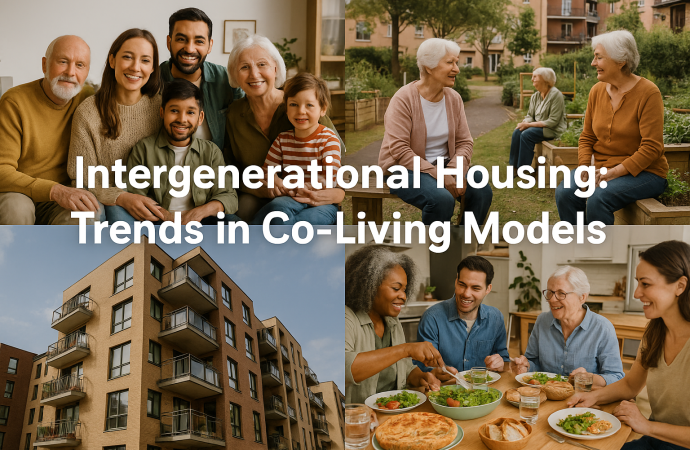What Is Intergenerational Co-Living? Intergenerational co-living places people from different age groups—students, working adults, parents with young children, and older adults—under one roof or within a shared complex. The goal is simple: trade space, skills, and companionship so everyone benefits. A college student gains below-market rent by tutoring kids, a retiree finds social life and
What Is Intergenerational Co-Living?
Intergenerational co-living places people from different age groups—students, working adults, parents with young children, and older adults—under one roof or within a shared complex. The goal is simple: trade space, skills, and companionship so everyone benefits. A college student gains below-market rent by tutoring kids, a retiree finds social life and help with errands, and families stretch budgets by splitting utilities. Unlike traditional roommate set-ups, intergenerational homes bake cooperation into design: multipurpose lounges, accessible bathrooms, and community calendars encourage daily connection.
Why Interest Is Rising in 2025
Housing Affordability Pressures
Rents and mortgages climbed faster than wages for a full decade. Young adults delay home-buying, while older homeowners struggle with fixed incomes and rising upkeep. Co-living evens the scales by pooling resources.
Loneliness Epidemic
Surveys show record levels of isolation among both seniors and Gen Z. Living with other age groups counters loneliness, offers role models, and reduces anxiety.
Work-From-Anywhere Culture
Hybrid jobs free employees to relocate. Many look beyond city centers, choosing rural or suburban co-living estates with built-in support networks.
Policy Shifts
Municipal zoning reforms now permit accessory dwelling units, micro-apartments, and flexible lot splits—legal tools that unlock creative intergenerational layouts.
How Modern Models Differ

Image by: Yandex.com
Home-Share Pairings
Homeowners, often empty nesters, rent spare rooms to students or young professionals at reduced rates. A formal agreement swaps rent for light chores—garden upkeep, tech help, grocery runs.
Purpose-Built Co-Living Complexes
Shared kitchens, gyms, and child-play zones sit at the core, plus event halls for weekly potluck dinners.
Clustered Tiny Homes
Small detached homes (400–600 sq ft) circle a common house. Residents gather for meals or craft classes, yet keep private space. Aging parents can downsize into a cluster while adult children remain nearby.
Rural Agri-Villages
Farms lease plots for modular homes. Younger tenants manage social media sales and field tasks; retirees share farming skills. Everyone splits produce and maintenance costs.
Design Trends Making Co-Living Work
Universal Accessibility
Wide corridors, zero-step entries, and lever handles aid strollers and wheelchairs alike. When design defaults to all-ages use, renovation costs drop over time.
Flex-Walls and Pocket Doors
Movable partitions change room sizes as family needs shift—home office by day, guest suite by night.
Tech-Enabled Scheduling
Apps reserve laundry slots, list daily meal themes, and match residents for ride-shares to doctor visits or concerts.
Energy Sharing
Solar micro-grids distribute power among units, cutting bills while teaching green stewardship across generations.
Benefits Beyond the Budget
Safety Net Extra eyes catch falls, emotional slumps, or sudden illnesses sooner than isolated living.
Sustainable Footprint Shared kitchens and bulk shopping reduce waste; carpooling trims emissions.
Stronger Civic Engagement Multi-age voting blocs advocate for park upgrades and safer crossings, boosting local quality of life.
Common Challenges and Practical Fixes

Image by: Yandex.com
Privacy Concerns
Solution: clear house rules, designated quiet hours, and lockable bedroom doors.
Uneven Chore Loads
Solution: rotating task charts tracked in a mobile app; credits carry forward so busy weeks even out later.
Interpersonal Conflicts
Solution: monthly resident meetings with a trained facilitator plus anonymous suggestion boxes.
Regulatory Hurdles
Solution: partner with nonprofits that navigate zoning, or use modular units classed as temporary structures to bypass density caps.
Tips for Prospective Residents
- Clarify Expectations Early Discuss rent, chores, and social time up front.
- Tour at Peak Hours Visit during dinner or after-school periods to gauge noise and interaction levels.
- Start With a Trial Lease Three- to six-month pilots let both sides test compatibility without long commitments.
- Join Community Events Potlucks and game nights speed the bonding process and set a cooperative tone.
- Stay Flexible Needs evolve. A family may welcome extra babysitting now but offer language lessons later.
Case Snapshots
The Bridge House, Portland
A converted craftsman hosts four seniors upstairs and three grad students downstairs. Residents share gardening tools and split monthly cooking classes, saving an estimated $500 each in food and utility costs.
Harmony Flats, Manchester
A 120-unit complex opened in 2024 with sliding rents tied to income. It features a rooftop greenhouse run by retirees; herbs supply an on-site café staffed by young parents returning to the workforce.
Sunfield Agri-Village, Queensland
Thirty micro-homes surround vegetable plots. High-school interns practice horticulture skills, while older farmers mentor them. Produce feeds residents and sells at a weekend market, covering community expenses.
How Governments Encourage Co-Living

Image by: Yandex.com
- Tax Incentives Property-tax reductions reward homeowners who legally host intergenerational tenants.
- Density Bonuses Developers gain extra floors in exchange for reserving units for mixed-age occupancy.
- Grant Programs City grants fund accessibility upgrades—ramps, elevators, smart sensors—that benefit all ages.
Future Outlook
Expect:
- AI Matching Platforms Algorithms pair households by lifestyle and skill complement.
- Insurance Discounts Fewer isolation-related claims make co-living communities attractive to insurers.
- Education Partnerships Universities embed dorm pods in senior campuses, blending coursework with real-life mentorship.
Conclusion
Intergenerational co-living blends economic relief with social richness. By redesigning homes around shared spaces, fair agreements, and age-inclusive features, residents swap loneliness for community and high bills for sustainable living.
















